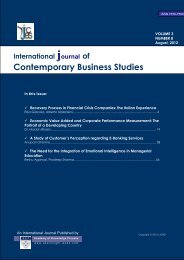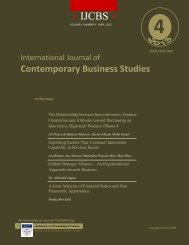International journal of Contemporary Business Studies
International journal of Contemporary Business Studies
International journal of Contemporary Business Studies
You also want an ePaper? Increase the reach of your titles
YUMPU automatically turns print PDFs into web optimized ePapers that Google loves.
<strong>International</strong> Journal <strong>of</strong> <strong>Contemporary</strong> <strong>Business</strong> <strong>Studies</strong><br />
Vol: 3, No: 6. June, 2012 ISSN 2156-7506<br />
Available online at http://www.akpinsight.webs.com<br />
Table 5 : Gender<br />
Frequency % Valid % Cumulative %<br />
Valid Male 149 78.0 78.4 78.4<br />
Female 41 21.5 21.6 100.0<br />
Total 190 99.5 100.0<br />
Missing 1 .5<br />
Total 191 100.0<br />
Table 6: Age<br />
Frequency Percent Valid Percent<br />
Cumulative<br />
Percent<br />
Valid 25-30 42 22.0 22.1 22.1<br />
31-35 73 38.2 38.4 60.5<br />
36-40 36 18.8 18.9 79.5<br />
41-45 17 8.9 8.9 88.4<br />
46-50 14 7.3 7.4 95.8<br />
51-55 3 1.6 1.6 97.4<br />
>55 5 2.6 2.6 100.0<br />
Total 190 99.5 100.0<br />
Missing System 1 .5<br />
Total 191 100.0<br />
Tables 6 demonstrate sample‟s age distribution. The major part <strong>of</strong> sample 38.4% , n= 73 was <strong>of</strong> the age<br />
group between 31-35. Only 1.5%, n= 3 respondents belong to the age group <strong>of</strong> 51-55 years (being the<br />
minority <strong>of</strong> the respondents). One respondent did not mentioned his/ her age.. From the following results<br />
it can be understood that the major part <strong>of</strong> sample consisted upon the faculty which represent the young<br />
cohort <strong>of</strong> age ranging from 25-35 years.<br />
Table 7 shows the sample composition in term <strong>of</strong> their tenure (Years <strong>of</strong> service), almost 104 respondents<br />
54.5% belong to service group <strong>of</strong> 1-5 years <strong>of</strong> service. 18.3 % <strong>of</strong> sample fall in to the service group <strong>of</strong> 6-<br />
10 years. The service group <strong>of</strong> 31-35 years service group represent the smallest cohort (n=3).<br />
Table 8 present Pearson correlation results among age, tenure, gender, and rank with overall job<br />
satisfaction level <strong>of</strong> sample, which is measured with JDI (Job Description Index). The coefficients <strong>of</strong><br />
correlation varied from -0.162 (Gender) and 0.724(age).Te Ranks and job satisfaction level <strong>of</strong> the<br />
respondents was significantly correlated (r=-0.828 at Significance level <strong>of</strong> 0.01, p< 0.01). On the other<br />
side age and job satisfaction level was also strongly correlated and significant (p< 0.01) (r= 0.724) as well<br />
as tenure & Job satisfaction (r=0.712) (p
















